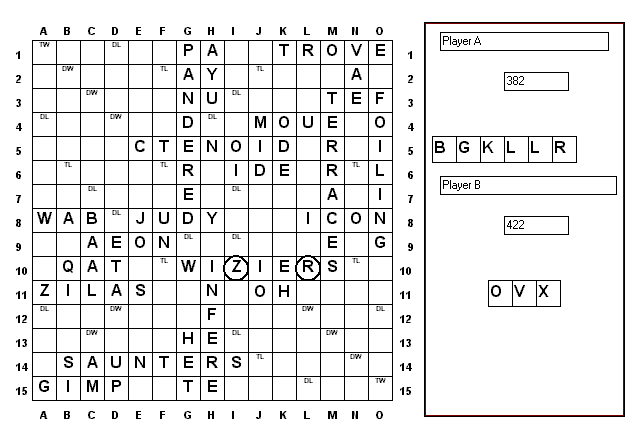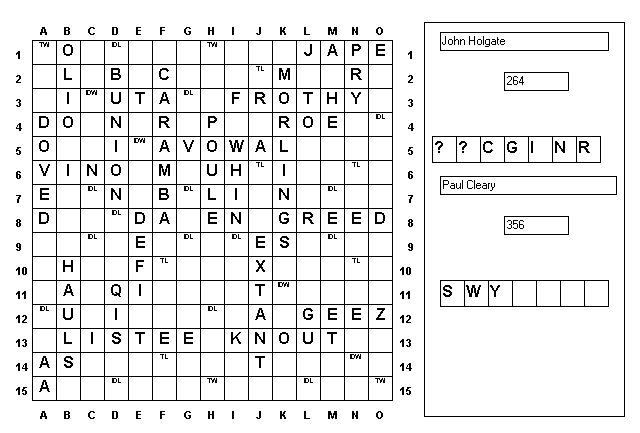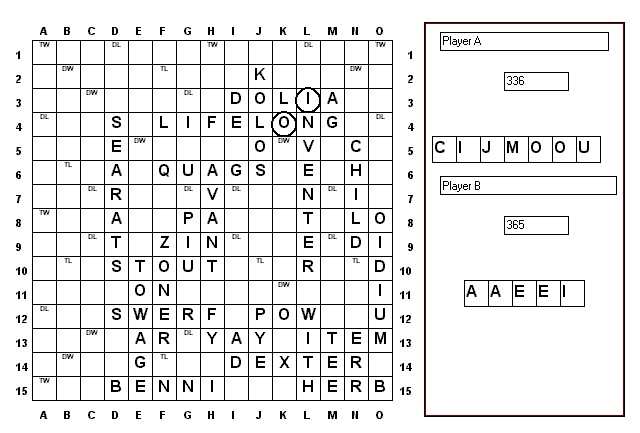Endgame Practice Sessions
Endgame Practice 1 :
Sticking your Opponent with the Q
These days, since the advent of QI, it is less common for players to be landed with an unplayable Q at the end of a game. This endgame is from a real situation in which the winner was quite resourceful with her low-scoring letters to reel in a big deficit.
It is player A's turn. Can you find a win for her?

What would you do?
The key to this game is obviously stopping your opponent playing out the Q then piling up points one letter at a time. The sums are: you block the Q and receive an extra 20 points which takes your score to 400 so you need to score 48 with your last seven tiles to win. The only Q-spot is on the second I of DIVINE (K2). You must block it with your lowest scoring tile (play TI not GI) which allows you to play TITI (K2) next time (getting two extra points from TI already on the board). GLIT (21)at 8L looks promising but uses up too many tiles and you would lose. After TI (2) - TITI (6), I12 VITA (7), B8 OI/RIZ (14), 2G MUG/GI (9) , 13M BRO/IRE (8) and finally UR (E13 or 7J) or ER (9M) for 2 points - a total of 48 and a one-point win.Endgame Practice Session 2:
A Trap for the Unwary
Here you are 40 points behind and have no vowels while your opponent has the X - normally a grim situation. Can you see a way to trap him with the X or V allowing you to 'paddle out' for a win?

What would you do?
An unwary player might play KAY at 2F for 20 points allowing VOX/OKAY for an inglorious defeat. Since your scoring hotspots (F2 and C13) are immune from attack you can block the main X-spot (PAX at 1G) with one of your L’s (1G PAL). Now if your opponent jettisons the X at 12E OX/SO he is left with an unplayable V. You can then score with impunity - KAY 2F and BAM on C13 followed by GIO J10, OIL I5 and OR/ERG N8 for a comfortable win.Endgame Practice 3:
Maximising your Margin
In this situation a player has his opponent on the ropes but decides to optimise the points spread.
How would you play this endgame to the best advantage? Remember Endgame Tip
Number 2 -
'break up your final rack into sets of two words and look for spots on the board
to play them.'
What would you do?
In this case it is probably not worth blocking the outplay spot for the V (VAR at A3) since optimising the margin is best done here by setting up either of the TWS’s at O1 or O8. Your opponent is vowelless and must dump the V leaving 6 points on his rack (D-L-N-T-T-V). 9L LUR/LAD/UG followed by O6 NOME /LURE yield 32 points but better still 2L LOR and O1 MENU/LORN = 33 or 3L MOR/MA followed by LUNE/MORN (O1) = 36 (plus at least 12 points on your opponent’s rack for a total of 48) and a final margin of 45 points.Endgame Practice 4:
Visualising the Blanks
This game was a tournament match between World Championship contestants Paul Cleary and John Holgate at the 1997 October Marathon in Sydney. Cleary has just played GEEZ for 56 at 12L and leads by 92. Two blanks can be hard to visualise but with one minute left on his clock Holgate managed a one point victory. Can you find the winning move?

What would you do?
The winning move was R(E)GENCIE(S)/KNOUTS at N5 through the two floating E’s. The play scored 75 plus 18 points for the S-W-Y on Cleary’s rack.Endgame Practice 5:
An Eskimo Boat to the Rescue
In this rather complex endgame you are 29 points behind. It is your move. Your opponent has 5 vowels but can go out in two with AIA at C3 and EE at C7, F2 or K7. Can you win the game?

What would you do?
Can you go out in two moves? Yes, MUJIK /IDE (28) at 2F followed by COO (14) at C3 or 1D. That scores 42 - plus points from your opponent’s rack. A cursory glance suggests he cannot score enough to overtake you. But look again! Did you know that CHILD takes an E - yielding REED at 10L for 21points. Sure you can counter with CREED/COO (18) at K10 but he goes out with AIA for 10 at C3 and wins.
Suddenly an Eskimo boat comes to your aid - UMIAC (also spelled UMIACK UMIAK OOMIAC OMIACK OOMIAK or UMIAQ). You can play it from the TWS at 8A for 27 putting you just 2 points behind with J-O-O left on your rack. You now have MOJO or JOMO (B6) for 29 to go out or (if blocked ) 2J JOOK/ODE for 19. Even if your opponent plays REED/CHILDE you still win by 6 points.
Endgame Practice 6: Expect the Unexpected
This curious endgame situation occurred in Round 13 of the 1997 World Scrabble Championships in Washington DC. The contestants were Roger Blom and John Holgate (both from Australia). Holgate has a 67 point lead with one tile remaining in the bag and little time left on his clock. Blom had just played the smart setup move LOAN/JO for 17 (SLOAN is a snub in Scotland) and Holgate knows the remaining tiles are A B E I N S S ? - yielding likely bonuses down columns D, F and K or along row 5. Within two minutes he had to calculate the likely outcome and make his winning move - can you?

So what happened?
Generally in an uncertain endgame players will go for points, dump as many tiles as possible and hope for the best. D4 CLAD for 19 (leaving C-F-R) is the obvious move putting you 86 ahead but it would lose to any 70-point bonus (plus double your leave - here 16 points plus the last tile you pick up).
Holgate passed his turn.
He realised that if Blom held the blank he could have two unplayable bonus moves from D1 or K1 (SABINES or BYSSINE, ARSINES or SANSEIS, INCASES or CAISSON, SALINAS or PAISANS, SABINES or BRASSIE etc).
But if Holgate passes and his opponent plays a bonus Blom picks up the last tile (remember Endgame Tip Number One ‘Leave the last tile in the bag’?). If Blom were to pass also Holgate would pass again and would win the game after both players had had three consecutive non-scores (under WSC rules). After Blom’s bonus Holgate could probably find counterplay off the TWS at H1 (with words like SCRAB, FRAB, BARF or FARAD).
As we have said before, Scrabble is a game of uncertainties. Blom actually played BANSAIS/LI/IS from F1 for 68. Now BANSAIS is not a word (BONSAIS and BANZAIS are okay). In the heat of battle Holgate thought Blom announced the second A as an H - BANSHIS, which is also unallowable (only BANSHIES and BANSHEES are good). But had to resist the knee-jerk reaction to challenge it off since he knew he could play BARF for 27 from 1F and Blom could only score 4 points from the last tile - an E. This gave Holgate a win by 4 points.
Could Blom have won the game? Yes. If he were to dump his B (say B11 BUG) he could have had a pair of unstoppable bonuses by drawing any five of the unseen eight letters. In fact if he had played RIZA (O10 for 13 points) he would have drawn the E for SABINES (D1) or BYSSINE (K1) and a certain win. Ah, the wisdom of hindsight.
